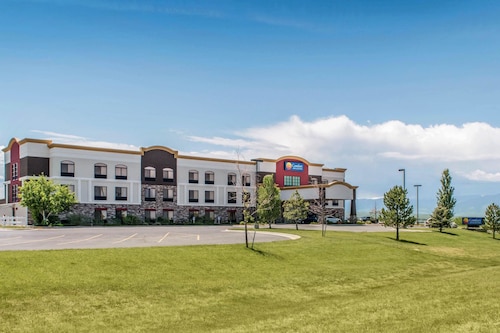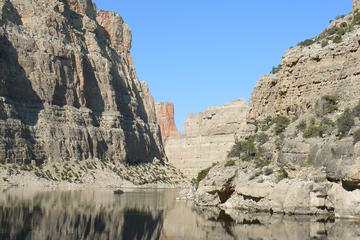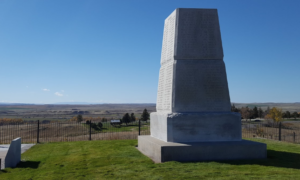Name Address Phone and Web Site for Little Bighorn Battlefield National Monument
Long Description for Little Bighorn Battlefield National Monument
In 1868, many Lakota leaders agreed to sign the Treaty of Fort Laramie. This treaty created a large reservation in the western half of present-day South Dakota. The United States wanted tribes to give up their nomadic life which brought them into conflict with other Indians, white settlers and railroads. Agreeing to the treaty meant accepting a more stationary life and relying on government-supplied subsidies. Lakota leaders such as Sitting Bull and Crazy Horse rejected the reservation system. Likewise, many roving bands of hunters and warriors did not sign the 1868 treaty. They felt no obligation to conform to its restrictions, or to limit their hunting to the unceded hunting land assigned by the treaty. Their forays off the set aside lands brought them into conflict with settlers and enemy tribes outside the treaty boundaries.
The Stage is Set
Tension between the United States and the Lakota escalated in 1874, when Lt. Col. George Armstrong Custer was ordered to make an exploration of the Black Hills inside the boundary of the Great Sioux Reservation. Custer was to map the area, locate a suitable site for a future military post, and to make note of the natural resources. During the expedition, professional geologists discovered deposits of gold. Word of the discovery of mineral wealth caused an invasion of miners and entrepreneurs to the Black Hills in direct violation of the treaty of 1868. The United States negotiated with the Lakota to purchase the Black Hills, but the offered price was rejected by the Lakota. The climax came in the winter of 1875, when the Commissioner of Indian Affairs issued an ultimatum requiring all Sioux to report to a reservation by January 31, 1876. The deadline came with virtually no response from the Indians, and matters were handed to the military.
General Philip Sheridan, commander of the Military Division of the Missouri, devised a strategy that committed several thousand troops to find and to engage the Lakota and Cheyenne, who now were considered “hostile,” with the goal of forcing their return to the Great Sioux Reservation. The campaign was set in motion in March of 1876, when a 450-man force of combined cavalry and infantry commanded by Colonel John Gibbon, marched out of Fort Ellis near Bozeman, Montana. General George Crook set out from Fort Fetterman in central Wyoming Territory with around 1,000 cavalry and infantry in late May. A few weeks before that, General Alfred Terry left from Fort Abraham Lincoln in Bismarck (Dakota Territory) with 879 men. The bulk of this force was the 7th Cavalry, commanded by Lt. Col. George Armstrong Custer.
It was expected that any one of these three forces would be able to deal with the 800-1,500 warriors they likely were to encounter. The three commands of Gibbon, Crook, and Terry were not expected to launch a coordinated attack on a specific Indian village at a known location. Inadequate, slow, and often unpredictable communications hampered the army’s coordination of its expeditionary forces. Furthermore, the nomadic lifestyle of the Lakota and Cheyenne people meant they were constantly on the move. No officer or scout could be certain how long a village might remain stationary, or which direction the tribe might choose to go in search of food, water, and grazing areas for their horses.
Visions and Reconnaissance
The tribes had come together for a variety of reasons. The region containing the Powder, Rosebud, Bighorn, and Yellowstone rivers was a productive hunting ground. The tribes regularly gathered in large numbers during early summer to celebrate their annual sun dance ceremony. This ceremony had occurred about two weeks earlier near present-day Lame Deer, Montana. During the ceremony, Sitting Bull received a vision of soldiers falling upside down into his village. He prophesized there soon would be a great victory for his people.
On the morning of June 25, the camp was ripe with rumors about soldiers on the other side of the Wolf Mountains, 15 miles to the east, yet few people paid any attention. In the words of Low Dog, an Oglala Lakota: “I did not think anyone would come and attack us so strong as we were.”
On June 22, General Terry decided to detach Custer and his 7th Cavalry to make a wide flanking march and approach the Indians from the east and south. Custer was to act as the hammer, and prevent the Lakota and their Cheyenne allies from slipping away and scattering, a common fear expressed by government and military authorities. General Terry and Colonel Gibbon, with infantry and cavalry, would approach from the north to act as a blocking force or anvil in support of Custer’s far ranging movements toward the headwaters of the Tongue and Little Bighorn Rivers. The Indians, who were thought to be camped somewhere along the Little Bighorn River, “would be so completely enclosed as to make their escape virtually impossible.”
Custer Takes Position
On the evening of June 24, Custer established a night camp twenty-five miles east of where the fateful battle would take place on June 25-26. The Crow and Arikara scouts were sent ahead, seeking actionable intelligence about the Lakota and Cheyenne. The returning scouts reported that the trail indicated the village turned west toward the Little Bighorn River and was encamped close by. Custer ordered a night march that followed the route that the village took as it crossed to the Little Bighorn River valley. Early on the morning of June 25, the 7th Cavalry Regiment was positioned near the Wolf Mountains about twelve miles distant from the Lakota/Cheyenne encampment along the Little Bighorn River.
Today, historians estimate the village numbered 8,000, with a warrior force of 1,500-1,800 men. Custer’s initial plan had been to conceal his regiment in the Wolf Mountains through June 25th, which would allow his Crow and Arikara scouts time to locate the Indian village. Custer then planned to make a night march, and launch an attack at dawn on June 26; however, the scouts reported the regiment’s presence had been detected by Lakota or Cheyenne warriors. Custer, judging the element of surprise to have been lost, feared the inhabitants would attack or scatter into the rugged landscape, causing the failure of the Army’s campaign. Custer ordered an immediate advance to engage the village and its warrior force.
At the Wolf Mountain location, Custer ordered a division of the regiment into four segments: the pack train with ammunition and supplies, three companies (125 men) commanded by Captain Frederick Benteen, three companies (140 men) commanded by Major Marcus Reno and five companies (210 men) commanded by Custer. Benteen was ordered to march southwest with the objective of locating any Indians, “pitch into anything” he found, and send word to Custer. Custer and Reno’s advance placed them in proximity to the village, but still out of view. When it was reported that the village was scattering, Custer ordered Reno to lead his 140 man battalion, plus the Arikara scouts, and to “pitch into what was ahead” with the assurance that he would “be supported by the whole outfit”.
Major Reno’s Command
The Lakota and Cheyenne village lay in the broad river valley bottom, just west of the Little Bighorn River. As instructed by Custer, Major Reno crossed the river about two miles south of the village and began advancing downstream toward its southern end. Though initially surprised, the warriors quickly rushed to fend off Reno’s assault. Reno halted his command, dismounted his troops and formed them into a skirmish line which began firing at the warriors who were advancing from the village. Mounted warriors pressed their attack against Reno’s skirmish line and soon endangered his left flank. Reno withdrew to a stand of timber beside the river, which offered better protection. Eventually, Reno ordered a second retreat, this time to the bluffs east of the river. The Lakota and Cheyenne, likening the pursuit of retreating troops to a buffalo hunt, rode down the troopers. Soldiers at the rear of Reno’s fleeing command incurred heavy casualties as warriors galloped alongside the fleeing troops and shot them at close range, or pulled them out of their saddles onto the ground.
Reno’s now shattered command recrossed the Little Bighorn River and struggled up steep bluffs to regroup atop high ground to the east of the valley fight. Meanwhile, Captain Benteen had returned after finding no evidence of Indians or their movement to the south. He arrived on the bluffs in time to meet Reno’s demoralized survivors. A messenger from Custer previously had delivered a written communication to Benteen that stated, “Come on. Big Village. Be Quick. Bring Packs. P.S. Bring Packs.” An effort was made to locate Custer after heavy gunfire was heard downstream. Led by Captain Weir’s D Company, troops moved north in an attempt establish communication with Custer.
Assembling on a high promontory (Weir Point) a mile and a half north of Reno’s position, the troops could see clouds of dust and gun smoke covering the battlefield. Large numbers of warriors approaching from that direction forced the cavalry to withdraw to Reno Hill where the Indians held them under siege from the afternoon of June 25, until dusk on June 26. On the evening of June 26, the entire village began to move to the south.
Custer’s Fate
The next day the combined forces of Terry and Gibbon arrived in the valley where the village had been encamped. The badly battered and defeated remnant of the 7th Cavalry was now relieved. Scouting parties discovered the dead, naked, and mutilated bodies of Custer’s command on the ridges east of the river. Exactly what happened to Custer’s command never will be fully known. From Indian accounts, archeological finds, and positions of bodies, historians can piece together the Custer portion of the battle, although many answers remain elusive.
It is known that after ordering Reno to charge the village, Custer rode northward along the bluffs until he reached a broad drainage known as Medicine Tail Coulee, a natural route leading down to the river and the village. Archeologial finds indicate some skirmishing occurred at Medicine Tail ford. For reasons not fully understood, the troops fell back and assembled on Calhoun Hill. The warriors, after forcing Major Reno to retreat, now began to converge on Custer’s maneuvering command as it forged north along what today is called Custer or Battle Ridge.
Dismounting at the southern end of the ridge, companies C and L appear to have put up stiff resistance before being overwhelmed. Company I perished on the east side of the ridge. The survivors rushed toward the hill at the northwest end of the long ridge. Company E may have attempted to drive warriors from the deep ravines on the west side of the ridge, before being consumed in fire and smoke in one of the very ravines they were trying to clear. Company F may have tried to fire at warriors on the flats below the National Cemetery before being driven to the Last Stand Site.
About 40 to 50 men of the original 210 were cornered on the hill where a stone monument now stands. Hundreds of Lakota and Cheyenne warriors surrounded them. Toward the end of the fight, soldiers, some on foot, others on horseback, broke out in a desperate attempt to get away. All were pulled down and killed in a matter of minutes. The warriors quickly rushed to the top of the hill, dispatching the last of the wounded. Superior numbers and overwhelming firepower brought the Custer portion of the Battle of the Little Bighorn to a close.
Aftermath
The battle was a momentary victory for the Lakota and Cheyenne. The death of Custer and his troops became a rallying point for the United States to increase their efforts to force native peoples onto reservation lands. With more troops in the field, Lakota hunting grounds were invaded by powerful Army expeditionary forces determined to conquer the Northern Plains Indians. Most of the declared “hostiles” had surrendered within one year of the fight, and the Black Hills were taken by the US government without compensation.
Where is Little Bighorn Battlefield National Monument - MAP :
CLICK ON THE MARKERS FOR MORE INFO
Places to stay and RV Parks near Little Bighorn Battlefield National Monument
Hotels for guests and family near Little Bighorn Battlefield National Monument
RV52 has conveniently geo-located hotels from Expedia.com into this area for you! Very reputable source.
Fun day trips near Little Bighorn Battlefield National Monument
Concerts, Sporting and other events near Little Bighorn Battlefield National Monument
Other attractions near Crow Agency, MT
Rent an RV near Crow Agency, MT! --> Outdoorsy Rentals
Videos related to Little Bighorn Battlefield National Monument
Searching for videos using this phrase : "Little Bighorn Battlefield National Monument"|"Crow Agency MT" -"for sale" -apartment
[tubepress mode="tag" tagValue='"Little Bighorn Battlefield National Monument"|"Crow Agency MT" -"for sale" -apartment ' fluidThumbs="true" " playerLocation="popup" resultsPerPage="12"]




























Leave a Reply